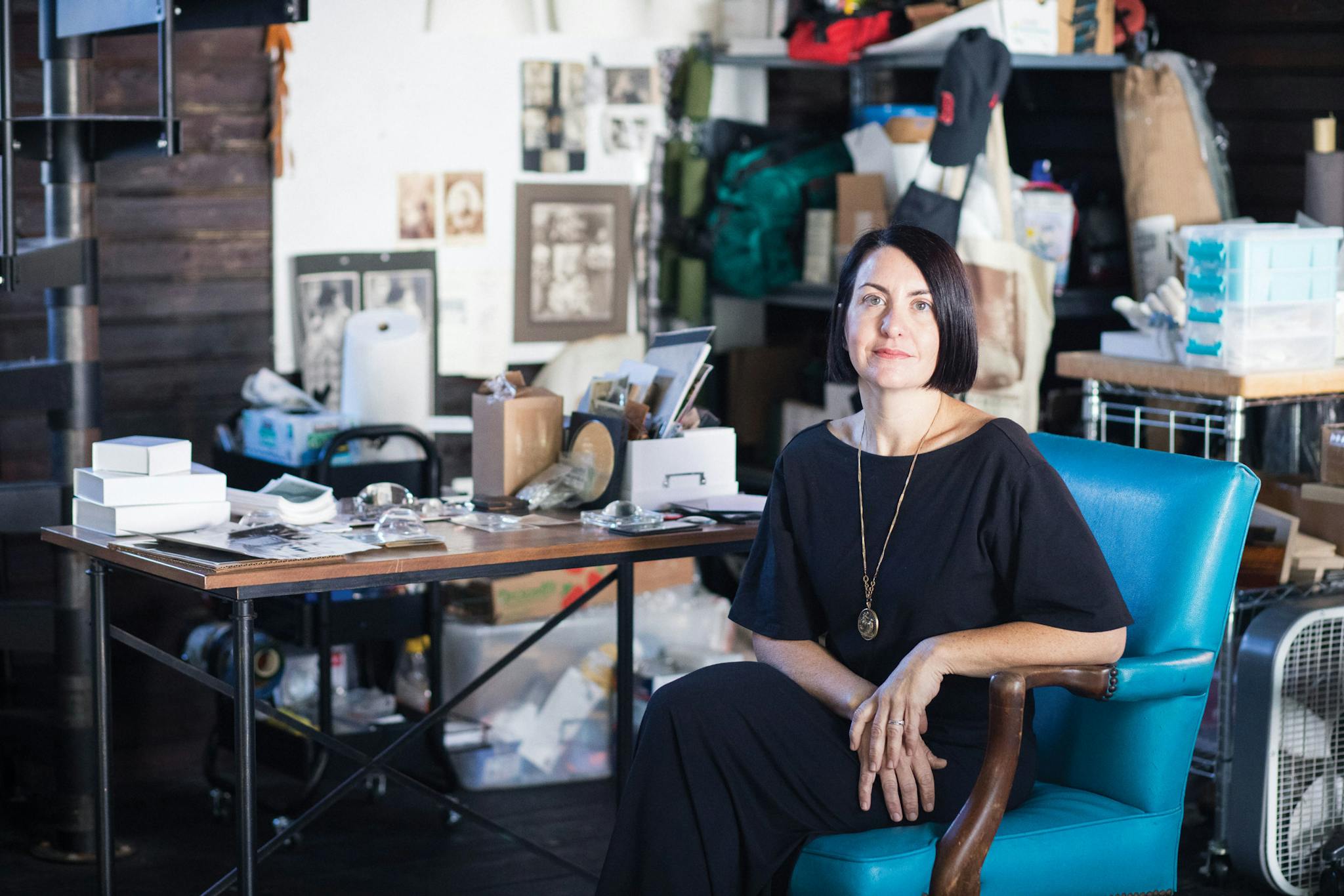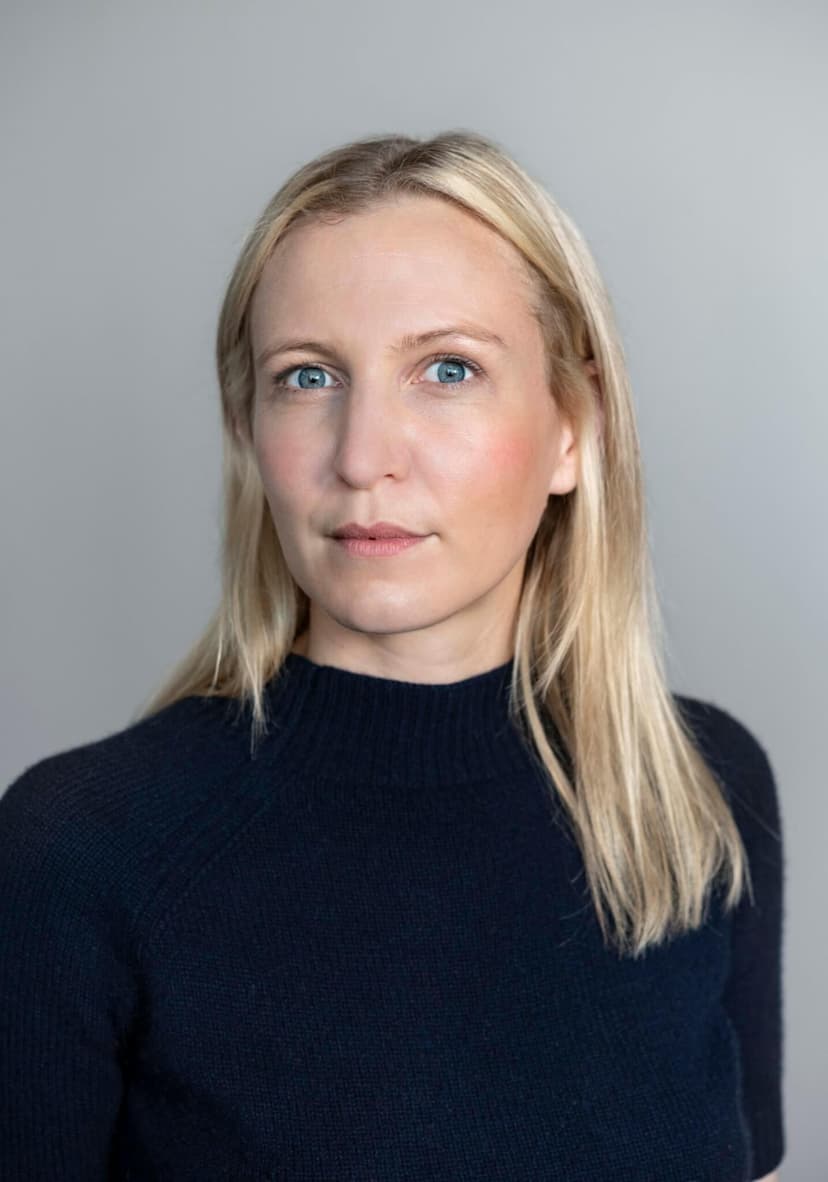Toni Pepe is a visual artist deeply curious about how photography shapes lived experience. I was fortunate enough to visit with her on a sweltering day in August when she opened her shaded home studio, cracked open cold seltzers for us, and showed me the work she’d been preparing for an upcoming exhibition at the Danforth Art Museum at Framingham State University (“Toni Pepe: Ordinary Devotion,” on view through January 29, 2023). What follows is a condensed version of the day’s conversation.
I was first drawn to Toni’s work because of my own research around how art and design meets the arc of human reproduction, historically and today. My interests resulted in a book and an exhibition, Designing Motherhood: Things That Make and Break Our Births, on which I collaborated with another wonderful design historian and a team of brilliant colleagues. Toni’s oeuvre doesn’t only focus on motherhood, but a substantial part of it does. So, we had a lot to talk about.
Toni’s work is the closest I’ve seen photography get to sculpture and installation. Her approach to the medium is multifaceted. Sometimes she’ll shine a strong light through an archival photograph that she’s found on eBay or in a library collection such that, when she re-photographs it, she captures both the image on the front and the marginalia scribbled and stamped on the back. At other times, she’ll arrange found photographs—including glass slides, negatives, and prints curled at the edges that look like they’ve been torn from someone else’s family album—in constellations held in place with prism slivers and telescopic lenses. Another approach etches found images onto glass and, using projected light, enlarges them as shadows on a wall. The result in each case is a palimpsest that turns image into object, recasting our relationship to it.
Both Toni and I are drawn to the topic of motherhood not because of any shared biology, but because it has historically been seen as marginal, taboo, and unworthy of sustained scholarly attention. We’re interested in the everyday, and we find richness in things that patriarchal, racialized socio-economic structures have resisted interrogating. I think we both enjoy doing work we’ve been told we’re not supposed to, and finding kinship in the very many people whose lives have been touched by reproduction, birth, pregnancy, and postpartum. After all, it’s how we all got here in the first place.
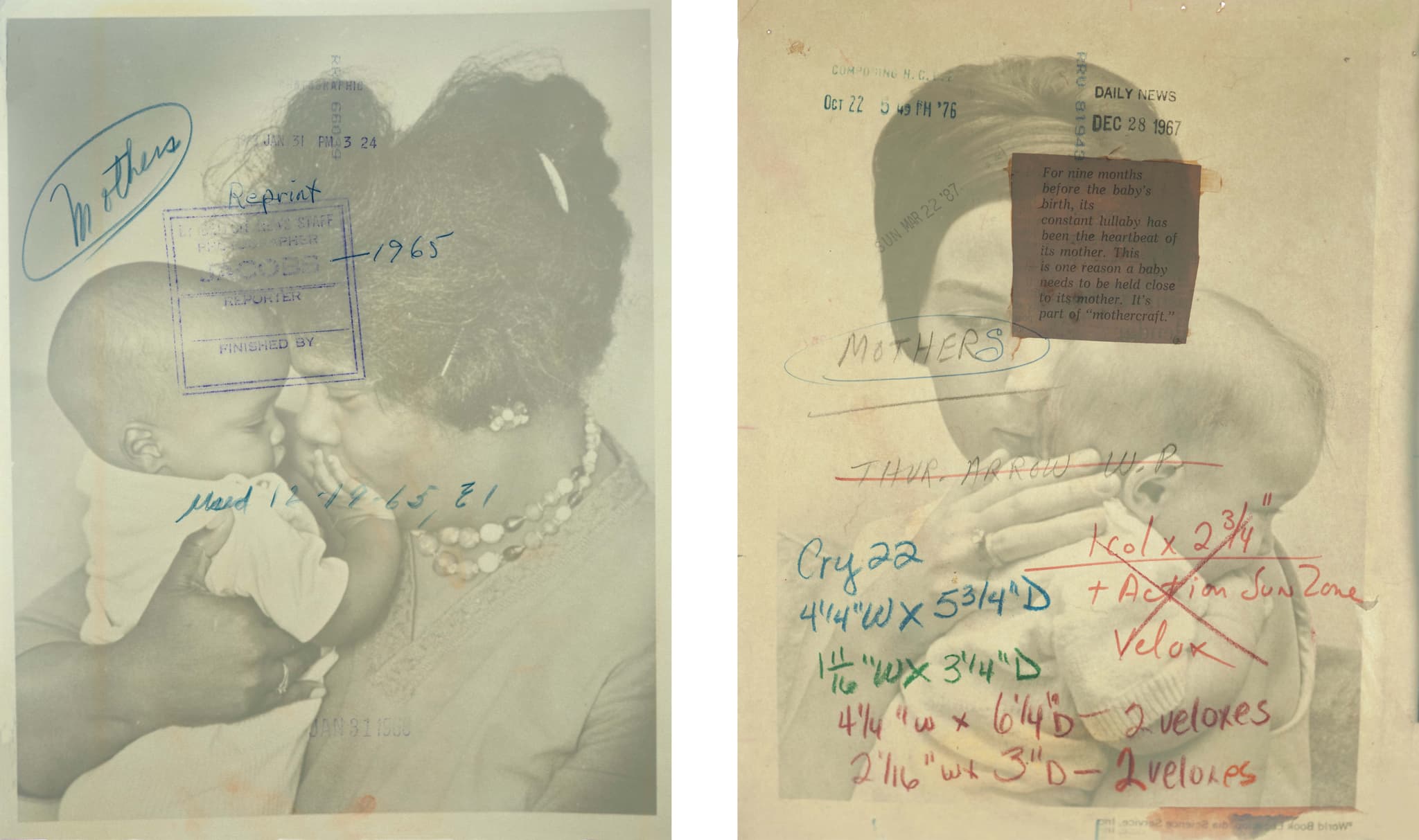
Left: Toni Pepe, Mothers, 2022. Archival inkjet. 28″ x 35″. “Mothers, used 12-14-65, 71.” Courtesy of the artist. Right: Toni Pepe, Mothercraft, 2022. Archival inkjet. 28″ x 35″. “For nine months before the baby’s born, its constant lullaby has been the heartbeat of its mother. this is one reason a baby needs to be held close to its mother. It’s part of ‘mothercraft.’” Courtesy of the artist.
Michelle Millar Fisher: For those who do not know your practice, can you introduce it?
Toni Pepe: In my work, I think specifically about our experiences of time and space—how a photograph compresses, distorts, and manipulates them, and how a photograph shapes our sense of self, both individually and collectively. What does it mean to look back at yourself and others repeatedly and from seemingly innumerable perspectives? And how does photography ground identity but then also splinter it? For the past ten years, my work has focused on motherhood and caretaking more broadly. In my practice, I allow my ideas to lead me toward materials or a particular process—and I use a range, from archival photographs, found family photographs, and laser etching to mold making and traditional photographic processes like cyanotype or digital capture. I want to illustrate the complexity of care.
MMF: That leads perfectly to my second question. The theme for this issue of BAR is burnout. It’s a term that has proliferated in use over the last couple of years. What does that term mean to you personally and professionally?
TP: For me, burnout doesn’t necessarily compartmentalize into professional and personal. It’s really about that push and pull between the two. I find the most fulfillment in my role as a mother alongside my role as an artist and educator. These roles come with many demands on my time, body, and emotions. I think a lot about the early years of parenthood; they’re incredibly physically and emotionally taxing. At that point, burnout just felt inevitable to me—all those sleepless nights. I wish I could go back in time and just be kinder to myself, telling myself, “You’ll get through it.” Now, I think less about each task having some sort of finish line. I think that’s what led to some of my burnouts; I felt like, “Oh, if I just finished this one thing, then I’ll be done.” But caretaking and art making are similar in that they’re never done. They’re endless. That finish line is an illusion. And I wouldn’t want them to be done; they’re a critical part of my humanity.
MMF: Can you talk a little bit about your Mothercraft series, which is what we initially bonded over? How and why did you come to this work?
TP: Mothercraft is an ongoing body of work in which I’m using press photographs that I have found at flea markets or through deep dives on eBay. I’m using them to reconsider twentieth-century depictions of mothers in the US media. I initially came to this work after being asked to participate in the Yellow Rose Project, a photography-based collaboration amongst one hundred artists across the US that responded to the centennial of the nineteenth amendment. That shifted my focus from family albums or vernacular photographs to press photographs, and I became more interested in public-facing images of women. The images I found ranged from the invention of the birth control pill to Mussolini on a balcony, giving a fascist speech praising the mothers of Italy for strengthening the country because they’re giving birth.
I’m attracted to old things that are used and marked by time. And some of these press photographs are just falling apart. They are objects in their own right—dirty, stained, marked, and layered. Much of that attraction comes from growing up with a father who worked with his hands and could fix anything. His garage is a lot like my studio; it’s just filled with objects that someone else deemed obsolete, but they would eventually find a new life and a new purpose in his hands. I always really admired that. In my studio, you’ll see similar things, too: a broken slide, or glass negative, or bits and pieces of a photograph, things that might appear to be trash, or were things that people just abandoned, but I take them in, and I’m hoping to give them a new life, to really show that their story isn’t done, that there’s some sort of legacy there to be recognized.
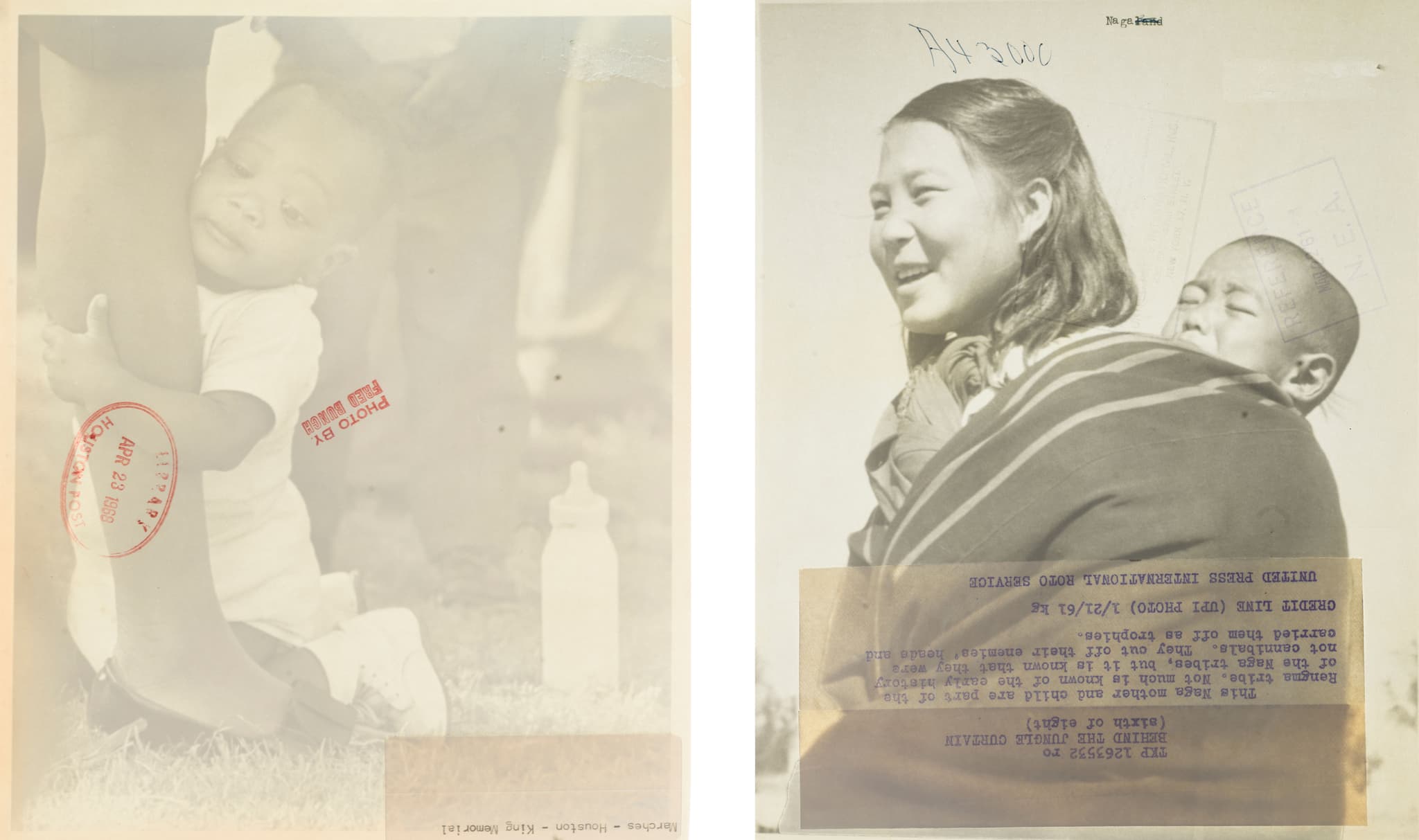
Left: Toni Pepe, Marches, 2022. Archival inkjet. 28″ x 35″. “Marches – Houston – King Memorial, April 23, 1968.” Courtesy of the artist. Right: Toni Pepe, Naga Land, 2022. Archival inkjet. 28″ x 35″. “This Naga mother and child are part of the Rengma tribe. Not much is known of the early history of the Naga tribes, but it is known that they were not cannibals. They cut off their enemies’ heads and carried them off as trophies.” Courtesy of the artist.
MMF: Everybody does at one stage, at least, have a mother—but mothering takes many, many different forms. So often, when we invoke “motherhood,” it’s perceived or presented in terms of blood relationships and the physical ability to procreate. What I love about your work is that in it, this labor and its attendant burnouts go far beyond those particular boundaries.
TP: I remember many years ago, when I first became a mother, searching for “mother” in Google Images, and it was nauseating how homogenous it was: white, heteronormative, unflinchingly happy. I knew I wanted my work to be something different. It’s about the labor of care more broadly, and I think of my work as an impossible archive. My efforts could never fully capture motherhood in its many forms, but this project reveals how rich this topic is, one that deserves attention.
MMF: Are there artists who you feel particularly connected to in their explorations of these ideas and issues?
TP: I’m always thinking about who I am in conversation with, and who has made room for me in the kind of work I’m doing right now. I feel a kinship with artists who have devoted their practice to the often overlooked or in the domestic space. Imogen Cunningham is a big one for me. She photographed the succulents in her garden in sharp contrast to her peers who were photographing majestic mountainsides. Judith Black created intimate portraits of her family while in graduate school at MIT. And it wasn’t work that she was encouraged to make, you know? I also think of Carrie Mae Weems’s The Kitchen Table Series (1990) and how she transformed mundane space into a stage that depicted the human drama of life. Illustrating the power and mystery of the familiar is central to my practice, so I’m always looking back at those artists who make work from what’s around them.
I’m indebted to Alice Neel’s unflinching approach to portraiture and Renee Cox’s powerful imagery of motherhood and Miriam Schapiro’s use of the decorative. I also must mention Moyra Davey. I am a fan of her artwork, but she also edited the Mother Reader, and I had to get two copies of the book because my original was destroyed through use. Literature is part of my practice. I look to writers while I’m working, and there’s been a significant uptick in writing about motherhood, which has been wonderful. Writers like Sheila Heti and Rachel Cusk; Claudia Dey’s essay for the Paris Review about “Mothers as Makers of Death” completely stopped me in my tracks and has inspired so much work that I’ve made. And then Mei-mei Berssenbrugge, her poetry, has a significant presence in my studio. I love how she creates layered images through words and how she writes about perception. That’s directly linked to my current use of prisms and lenses.
MMF: I think what you say about Judith Black is true for so many artists. I think of the conversation I had recently with Tabitha Soren, an artist in the “Designing Motherhood” exhibition, who created a body of work on the labor of mothering and was told repeatedly, “It’s not really worth developing.” And so she waited about fifteen years before doing anything with those images. Same with Deb Willis, actually, who waited almost two decades before developing photographs of herself pregnant. It was her son who said, “Actually, you should do something with these, Mom. They’re amazing.” And they are.
TP: Yes!
MMF: Have you ever felt or been made to feel that exploring care work, or mothering, or the labor that goes into raising children are ideas outside the parameters of the contemporary art world, or have you always felt particularly comfortable pursuing them?
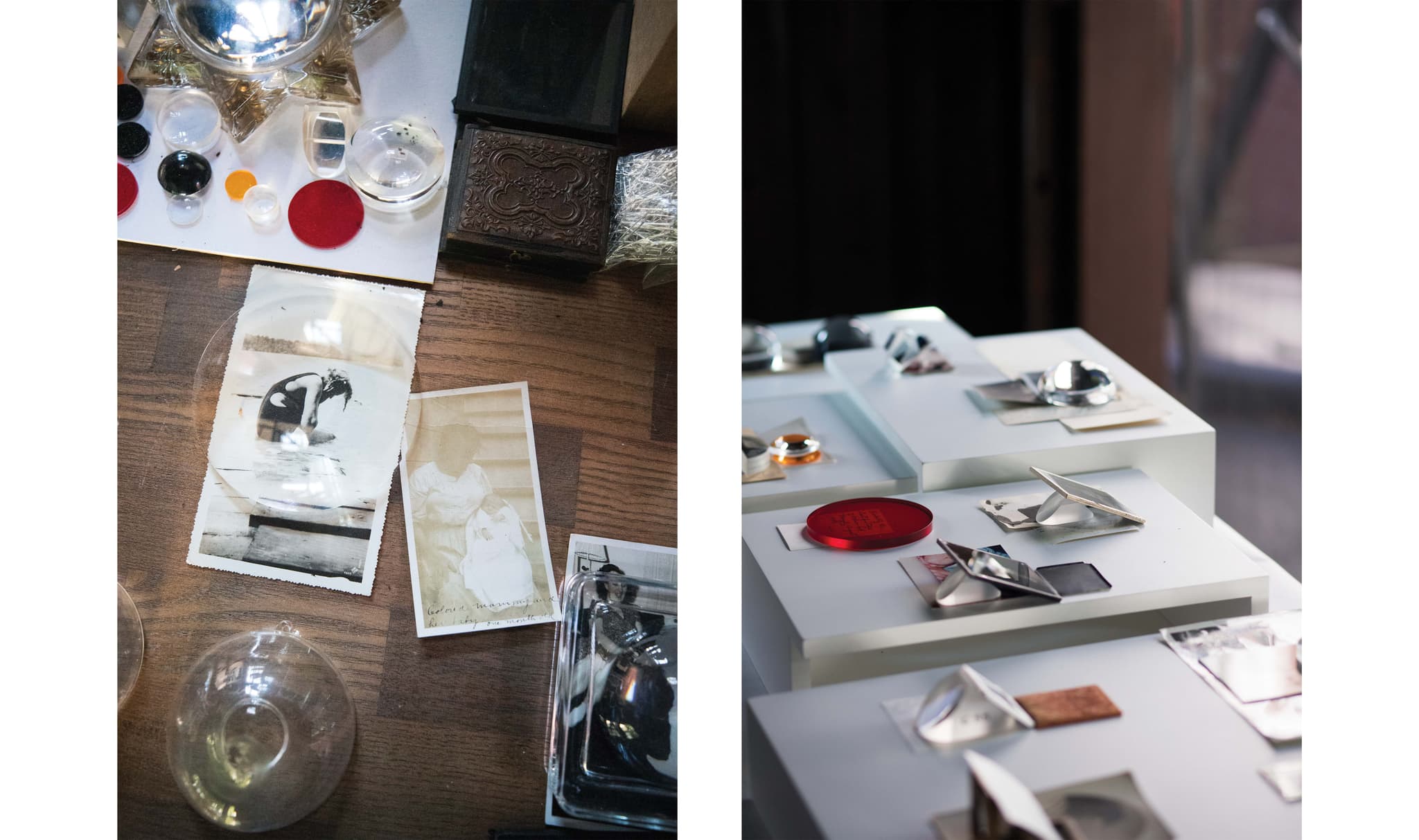
Inside Toni Pepe’s studio, fragments of glass sit atop film negatives. Photo by Carlie Febo for Boston Art Review.
TP: I always want to feel uncomfortable in my practice. I feel like it’s my job to make myself squirm and my viewers squirm. Feeling comfortable is not something that I look for. But I always had that strong sense of the artists who came before me to support me. I will say that I try to fight against the categorization of “mother artist.” It’s very limiting, very restrictive, and it just feels unnecessary. My work focuses on motherhood and caretaking, but the results reveal a more comprehensive conversation and include many collaborators involved in care beyond the individual mother figure.
MMF: I was struck by the object-ness of your work when I visited your studio. You talked about that early moment developing a photograph, but during the arc of your career photography has become increasingly dematerialized. Your work remains really physical. You talked about how important it is for people to actually encounter your work in order to really get it. Can you talk a little bit more about your insistence in being present in that way with photography?
TP: I’ve always been interested in the relationship between the body and the photograph. My earlier work, which pictures performances using myself and my children, was physically exhausting to make, and I never used a remote trigger. Instead, I insisted on the back and forth and repositioning myself for each frame. I would be worn out by the time those pictures were taken. I also surrounded myself in those images with objects I collected and found. In my current work, the physicality of the print really draws me, and the stains, the handwriting, the creases. Each print is a palimpsest of information, a layering of time, and an indicator of the hands these prints have passed through.
Much of what we have experienced over the past few years through the pandemic has happened through a screen. My work rejects the slick, shiny display that can be a barrier between the senses. I want you to be able to smell the work, move around it, experience scale, move close or back up, and better understand the possibilities and limitations of your own sight and that seeing does not only involve the eyes.

Left: Toni Pepe, First Legal Abortion (Illinois), 2022. Archival inkjet. 28″ x 35″. “Dr. Marvin Rosner performed the first legal Illinois abortion Monday.” Courtesy of the artist. Right: Toni Pepe, Off Playing Bridge, 2022. Archival inkjet. 28″ x 35″. “Dennis O’Neal, 6 months, screaming for his mother who is off playing bridge.” Courtesy of the artist.
MMF: That’s a perfect segue into our penultimate question, because you are preparing for an exhibition at the Danforth Art Museum, right?
TP: The exhibition was initially planned to open in 2020, and for obvious reasons was postponed, but I’m so grateful for the extra time that I was given, because it would’ve been a drastically different show two years ago. I was able to make mistakes and go down creative rabbit holes and ultimately take more risks. This exhibition is really now a culmination of eight years in the studio. I tend to work very slowly and revisit things over the course of several years. The exhibit will include photography in its many forms, and I like to think of it a little bit as this love letter to photography. It includes found photographs and cyanotype, but then also sculpture and installation. When I’m using materials that may at first appear to be outside of photography, I’m really thinking about them as a photographer. I’m thinking about ideas like the trace, or impression, and the body, and the relationship or the link that they have to photography.
MMF: I love those indexical relationships between the found-ness or the object-ness and the ways in which photography works. The very last question I have, Toni, is how would you characterize living and working as an artist in Boston?
TP: I think one of the most positive aspects is the community. I don’t work alone in my studio; my practice relies heavily on feedback and the help of my peers, fellow artists, and curators. These ongoing conversations feed my process and my work, and oftentimes will guide me toward alternative approaches that maybe I wouldn’t have found on my own. In Boston, too, we have a slew of institutions and collections to dive into.
MMF: I saw a picture of you in the Schlesinger Library archives the other day and I was so excited. Is that pointing towards future places of research for you?
TP: Oh, you did? Yeah, I’m excited to see where Mothercraft will go when I start to use more of the institutionalized imagery, and the Schlesinger has an amazing collection. I have just scratched the surface, and I’m looking forward to scratching more!
